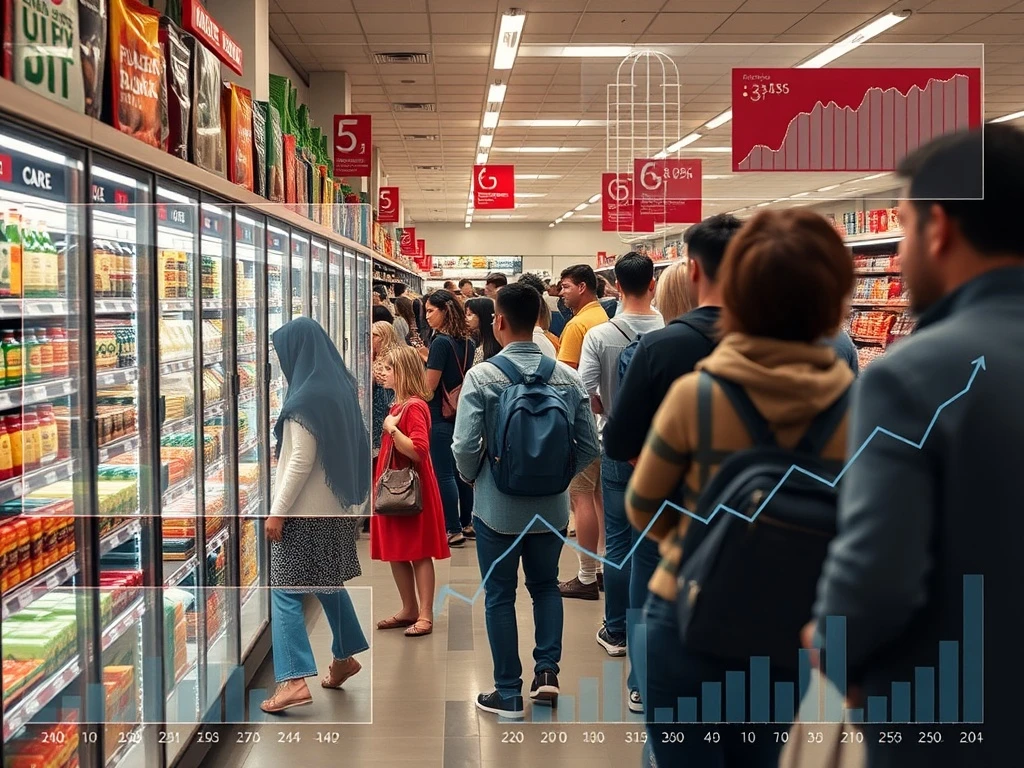Understanding the pulse of the economy often begins in the aisles of major retailers. Walmart, a titan in the retail sector, consistently provides a crucial snapshot of American consumer spending. Its quarterly earnings reports, alongside those of its key rivals, offer unparalleled insights into the financial health of households across the nation. This detailed analysis helps economists, investors, and policymakers grasp current economic realities. Therefore, these reports are far more than just financial updates; they are vital economic indicators.
Decoding Consumer Spending Through Retail Giants
Retail earnings reports serve as a direct window into the behavior of the average shopper. Specifically, Walmart’s extensive reach across demographics and geographies makes its data particularly representative. When Walmart reports, it reveals not only its own performance but also broader trends in consumer spending. Other major retailers, from Target to Amazon, also contribute to this comprehensive picture. Collectively, their results paint a vivid landscape of purchasing power and priorities.
For instance, these reports often highlight shifts in purchasing patterns. Are consumers buying more private-label brands? Are they prioritizing essentials over discretionary items? These questions find answers in the sales figures. Furthermore, the reports show how inflation influences buying decisions. Consequently, a clearer understanding of economic pressures emerges.
The Significance of Walmart’s Financial Disclosures
Walmart’s position as the world’s largest retailer gives its financial disclosures immense weight. Its performance directly reflects the economic well-being of millions of households. Thus, analysts scrutinize every detail, from average transaction size to e-commerce growth. These figures provide a granular view of how economic conditions affect everyday purchasing. Furthermore, they reveal how different income segments are adapting to current financial pressures.
For example, a notable increase in grocery sales coupled with a decline in electronics might suggest budget tightening. Conversely, robust sales across all categories could signal strong consumer confidence. Walmart’s vast network allows it to capture these subtle shifts quickly. Its ability to manage inventory and supply chains also provides clues about future economic conditions. Therefore, its reports are often a bellwether for the broader economy.
Inflation’s Persistent Grip on Consumer Spending
One of the most pressing issues facing consumers today is persistent inflation. Retail reports provide concrete evidence of its impact on consumer spending. CEOs frequently discuss how rising costs for goods and services affect their customers’ wallets. This includes everything from groceries to gasoline. Consequently, consumers often adjust their purchasing habits significantly.
Retailers respond in various ways. They might offer more promotions or expand their private-label offerings. These strategies aim to provide more affordable options. Furthermore, companies often highlight their efforts to absorb some costs to protect consumers from higher prices. However, these efforts have limits. Ultimately, inflation forces consumers to make difficult choices. This pressure is a key concern for many households.
Supply Chain Challenges and Their Retail Impact
Global supply chain disruptions continue to pose significant challenges for retailers. These issues directly affect product availability and pricing. Retail reports often detail how companies are navigating these complexities. For instance, they might discuss increased shipping costs or delays in receiving inventory. These factors can lead to higher prices for consumers. Therefore, efficient supply chain management remains critical.
Retailers are investing heavily in improving their logistics networks. They are diversifying sourcing and building more resilient supply chains. These investments aim to minimize future disruptions. Ultimately, a stable supply chain ensures products reach shelves consistently. This stability directly impacts consumer confidence and their willingness to spend. Any mention of supply chain improvements or persistent bottlenecks offers further insight into the economic landscape.
The ‘Elephant in the Room’: What CEOs Address
Beyond the raw numbers, the commentary from retail CEOs provides invaluable context. These leaders often address the ‘elephant in the room’ – the unspoken, yet widely felt, economic pressures. This includes topics like:
- Interest Rate Hikes: How rising rates impact consumer borrowing and big-ticket purchases.
- Labor Market Dynamics: The availability of workers and wage growth’s effect on disposable income.
- Consumer Debt Levels: The increasing reliance on credit cards and its sustainability.
- Savings Rates: Whether households have sufficient buffers against economic shocks.
- Geopolitical Events: How global conflicts or trade disputes influence supply and demand.
- Future Economic Outlook: Predictions about recession risks or recovery potential.
These discussions offer a qualitative layer to the quantitative data. They help paint a complete picture of the economic environment. Moreover, they signal potential future challenges or opportunities. Investors and analysts listen closely for these insights.
Navigating Economic Headwinds: Retailer Strategies for Consumer Spending
In challenging economic times, retailers adopt specific strategies to maintain sales and customer loyalty. These approaches directly influence consumer spending patterns. Companies often focus on value propositions. This means emphasizing affordability and promotions. They also invest in private-label brands, which typically offer lower prices than national brands. This helps consumers stretch their budgets further.
Furthermore, retailers are enhancing their e-commerce capabilities. Online shopping provides convenience and often allows for easier price comparisons. Loyalty programs also play a crucial role. These programs offer discounts and personalized offers. Ultimately, these strategies aim to keep consumers engaged. They also help retailers adapt to evolving market conditions. Consequently, they remain competitive even during downturns.
Broader Economic Implications of Shifting Consumer Spending
The trends in consumer spending revealed by major retailers have far-reaching implications for the entire economy. A robust consumer base drives economic growth. Conversely, a slowdown in spending can signal an impending recession. Therefore, economists closely monitor these retail reports. They use this data to forecast GDP growth and inflation rates. Policymakers also rely on this information to make informed decisions about monetary and fiscal policies.
For instance, if consumers reduce discretionary spending, it impacts sectors beyond retail. Hospitality, entertainment, and travel industries also feel the effects. Moreover, sustained shifts in consumer behavior can lead to long-term changes in market dynamics. This influences investment decisions and business strategies across various industries. Ultimately, the health of the consumer directly correlates with the overall economic outlook.
In conclusion, the earnings reports from Walmart and its competitors offer an unparalleled look into the state of the consumer. These reports provide both quantitative data and qualitative insights into the forces shaping our economy. By understanding the nuances of consumer spending, we gain a clearer perspective on current challenges and future prospects. These disclosures are essential for anyone seeking to understand the economic landscape.
Frequently Asked Questions (FAQs)
Q1: Why are Walmart’s earnings reports so important for understanding consumer spending?
A1: Walmart is the world’s largest retailer, serving a vast demographic across various income levels. Its sales data and commentary provide a comprehensive, real-time snapshot of how millions of American households are spending their money, reflecting broader economic trends.
Q2: What is the ‘elephant in the room’ that retail CEOs might discuss?
A2: The ‘elephant in the room’ refers to significant, often challenging, economic factors that directly impact consumers and businesses. This includes topics like persistent inflation, rising interest rates, labor market shifts, consumer debt levels, and the overall risk of an economic downturn.
Q3: How does inflation affect consumer spending, according to retail reports?
A3: Retail reports show that inflation often leads consumers to prioritize essential goods over discretionary items. They may also opt for private-label brands, seek out promotions, and generally become more price-sensitive, impacting overall sales volumes and profit margins for retailers.
Q4: What strategies do retailers use to encourage consumer spending during economic challenges?
A4: Retailers often focus on value propositions, such as expanding private-label offerings, increasing promotions, and enhancing loyalty programs. They also invest in e-commerce and improve supply chain efficiency to offer competitive pricing and consistent product availability.
Q5: How do retail reports help economists and policymakers?
A5: Economists use retail data to forecast GDP growth, inflation, and employment trends. Policymakers rely on this information to make informed decisions regarding monetary policy (like interest rates) and fiscal policy (like government spending or tax initiatives) to stabilize the economy.
Q6: What is the long-term significance of shifts in consumer spending patterns?
A6: Sustained shifts in consumer spending can indicate fundamental changes in economic conditions or consumer priorities. These shifts can influence long-term investment decisions, reshape industries, and even lead to new market opportunities or challenges for businesses across the economy.








